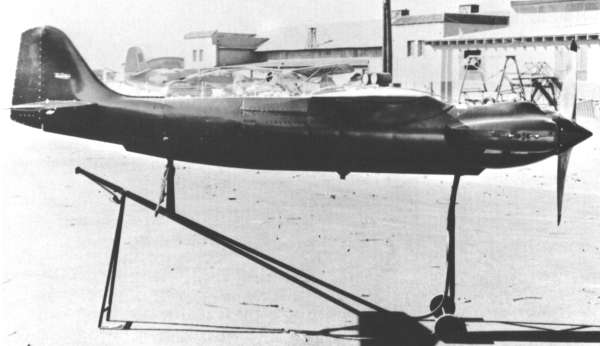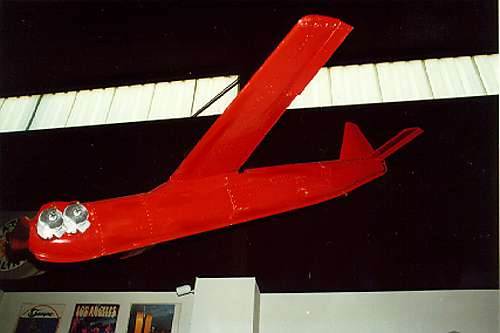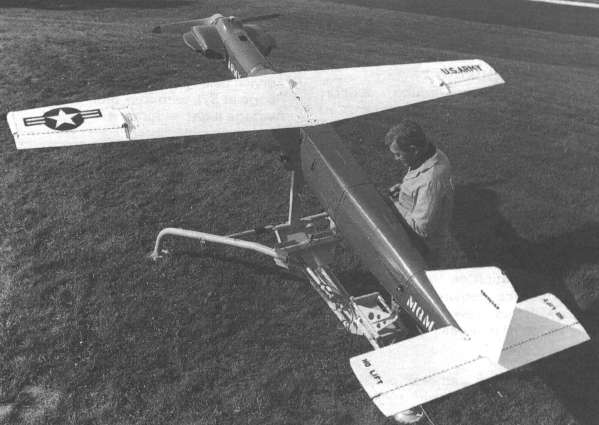Northrop (Radioplane) OQ-19/KD2R/MQM-33
The MQM-33 is a simple propeller-driven full-scale aerial target. In production in various versions for over 40 years, the MQM-33 family is one of the most successful targets ever built.
In 1945, Radioplane created the Model RP-19 by replacing the O-45 engine in the OQ-17 target with a higher-rated O-90 engine. The RP-19 was tested by the USAAF as the YOQ-19 in July 1945, and ordered into production in 1946 as the OQ-19A. The OQ-19A had a metal fuselage and wooden wings (later OQ-19As would use metal wings). Like all following members of the family, it could be launched from a catapult launcher, a rotary launcher, or from a zero-length launcher with the aid of a 9.6 kN (2160 lb) thrust solid-fueled booster rocket. The Air Force drones could also be air-launched, usually from DB-26C aircraft. The OQ-19s were controlled from the ground by a radio command link, which used an AN/URW-3 transmitter and an AN/ARW-26AY receiver. Recovery was by parachute, which was deployed by radio command or automatically after loss of vital systems. The OQ-19C was a derivative of the OQ-19A, which had metal wings from the beginning and a significantly modified vertical tail without a rudder. The OQ-19C used the same O-90 engine as the OQ-19A.
 |
| Photo: Northrop |
| OQ-19A |
In 1950, the XOQ-19B was tested with metal wings, a more powerful O-100 engine, and a vertical gyro for out-of-sight operation. This model was produced as the OQ-19B and could be tracked by the out-of-sight operator using an X-band radar tracking system. The OQ-19D, first flown in April 1950, was similar to the OQ-19B, but lacked the out-of-sight operation capability, and was optically tracked using drone-mounted smoke flares or lights. The OQ-19B/D used the same rudder-less vertical tail as the OQ-19C. The OQ-19B/D was also used by the U.S. Army, and it is possible that one of these versions was designated XM23E1 by the Army.
 |
| Photo: Northrop |
| OQ-19B/D (MQM-33A/B) (exact version unknown) |
Beginning in 1960, the U.S. Army flight-tested the OQ-19E (Radioplane Model RP-92), which was essentially a new aircraft with a new circular-section fuselage, reinforced wings and a McCulloch O-150-4 turbocharged engine. Although the OQ-19E showed good performance, no production order followed, and the program was terminated in 1961.
The U.S. Navy also used the OQ-19 family of drones, designating them in the KD2R Quail series. The initial Navy production version was the KD2R-1, identical to the OQ-19A. The KD2R-2 was similar to the -1, except for a 28V radio and a stabilization system. The NAMTC (Naval Air Missile Test Center) tested modified stabilization systems in the KD2R-2E. The KD2R-3 was identical to the OQ-19D, and the XKD2R-4 was a development of the -3 except for engine and stabilization system. It is possible that the XKD2R-4 was similar to the OQ-19E.
 |
| Photo: Sun 'n Fun |
| KD2R-3 (OQ-19D, MQM-33B) |
The KD2R-5 Shelduck was an improved model, which was later redesignated as MQM-36A.
Between 1950 and 1960, the OQ-19/KD2R was built in very large numbers, including almost 20000 OQ-19s of all versions for the USAF and the Army. The target was used for anti-aircraft gunnery and surface-to-air missile training. By 1963, only the OQ-19B/D versions were still in use by the Army, and the Navy had discarded all models except for the KD2R-5. In June that year, the variants still in service were redesignated as follows:
| Old Designation | New Designation |
|---|---|
| OQ-19B | MQM-33A |
| OQ-19D | MQM-33B |
| KD2R-5 | MQM-36A |
In 1973, Northrop introduced a new G-band command and control system for the MQM-33 targets. When equipped with this system, the MQM-33A and MQM-33B became the MQM-33C and MQM-33D, respectively. Production of the MQM-33C for the U.S. Army National Guard continued until the late 1980s, but it's no longer in service with the Army.
 |
| Photo: via Jane's |
| MQM-33C |
In the 1980s, the OQ-19 drone family was generally referred to as BTT (Basic Training Target), and more than 73000 drones of all BTT versions (OQ-19, KD2R, MQM-33, MQM-36) were built. Another derivative of the MQM-33 was the MQM-57 Falconer surveillance drone.
Specifications
Note: Data given by several sources show slight variations. Figures given below may therefore be inaccurate!
Data for OQ-19D (MQM-33B):
| Length | 3.73 m (12 ft 3 in) |
| Wingspan | 3.48 m (11 ft 5 in) |
| Height | 0.79 m (2 ft 7 in) |
| Weight | 145 kg (320 lb) |
| Speed | 370 km/h (230 mph) |
| Ceiling | 7620 m (25000 ft) |
| Endurance | 60 min. |
| Range | 320 km (200 miles) |
| Propulsion | McCulloch O-100-1 piston engine; 54 kW (72 hp) |
Main Sources
[1] Richard A. Botzum: "50 Years of Target Drone Aircraft", Northrop, 1985
[2] Kenneth Munson: "World Unmanned Aircraft", Jane's, 1988
[3] Kenneth Munson (ed.): "Jane's Unmanned Aerial Vehicles and Targets, Issue 15", Jane's, 2000
[4] R.T. Pretty, D.H.R. Archer (eds.): "Jane's Weapon Systems 1972-73", Jane's, 1973
[5] Norman J. Bowman: "The Handbook of Rockets and Guided Missiles", Perastadion Press, 1963
[6] "Characteristics Summary OQ-19D", U.S. Air Force, 1954 & 1960
Back to Current Designations Of U.S. Unmanned Military Aerospace Vehicles
Back to Directory of U.S. Military Rockets and Missiles
Last Updated: 19 January 2003